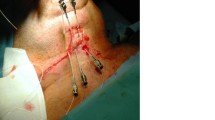Aim:
To evaluate the impact of postoperative interstitial brachytherapy with and without external radiotherapy in the treatment of primary and recurrent squamous cell carcinoma of the oral cavity and oropharynx.
Patients and Methods: Between 1985 and 1997, a total of 318 patients were treated by interstitial Ir-192 low-dose-rate brachytherapy as part of their primary (n = 236) or recurrent treatment (n = 82). There were 263 male (83%) and 55 (17%) female patients. The distribution of UICC (1997) stages was as follows: I (61 patients, 19%), II (71 patients, 22%), III (58 patients, 18%), IV (128 patients, 40%). The primary tumor site was located in the oral cavity in 201 patients (63%), in the oropharynx in 86 patients (27%), lower lip in 19 patients (6%) and other regions in twelve cases (4%). Treatment concepts did not vary over the time and were dictated by the initial tumor extension: a total of 175 patients (55%) received a combination of surgery, interstitial brachytherapy (23–25 Gy) and external radiotherapy (50–60 Gy), 60 patients (19%) surgery and interstitial brachytherapy (45–55 Gy) alone. Advanced disease not amenable to primary surgery was either treated by radiochemotherapy and interstitial brachytherapy in 39 patients (12%) or a combination of interstitial brachytherapy, external radiotherapy and interstitial hyperthermia in 44 patients (14%).
Results: Overall survival rates following primary and recurrent treatment were 50 ± 4% and 29 ± 5%, respectively, at 5 years (p < 0.0001). A significant impact on overall survival rate was noted for UICC stage: patients in stage I/II had survival rates of 64 ± 5% and 57 ± 10%, respectively, while patients in stage III/IV had survival rates of 39 ± 5% and 15 ± 5%, respectively, at 5 years (p < 0.0001). In addition, grading (p = 0.01) and hemoglobin levels (p = 0.05) had a significant influence on overall survival. Local tumor control rates for all patients were 74 ± 3% and 57 ± 7% at 5 years following primary and recurrent treatment (p = 0.01), respectively. The 145 patients treated for primary disease by a uniform concept of surgery, interstitial brachytherapy and external radiotherapy achieved excellent local control rates with 92 ± 4% (stage I/II) and 65 ± 6% (stage III/IV) at 5 years. Late treatment-related toxicity with soft tissue necrosis and/or osteonecrosis requiring mandibular resection was 7.5%.
Conclusion: Local tumor excision followed by postoperative interstitial brachytherapy with and without external radiotherapy is associated with excellent locoregional control, a low risk of chronic sequelae and may therefore considered as a new approach avoiding mutilating radical surgery.
Zielsetzung:
Es sollte der Einfluss der postoperativen interstitiellen Brachytherapie mit und ohne externe Radiotherapie in der Behandlung von primären und rezidivierten Plattenepithelkarzinomen der Mundhöhle und des Oropharynx untersucht werden.
Patienten und Methoden: Zwischen 1985 und 1997 wurden insgesamt 318 Patienten mit einer interstitiellen Iridium-192-low-dose-rate-Brachytherapie als Teil der Primärbehandlung (n = 236) oder der Rezidivbehandlung (n = 82) therapiert. Es waren 263 Männer (83%) und 55 Frauen (17%). Die Verteilung der UICC-Stadien (1997) war wie folgt: I (61 Patienten, 19%), II (71 Patienten, 22%), III (58 Patienten, 18%), IV (128 Patienten, 40%). Die primäre Tumorregion betraf die Mundhöhle bei 201 Patienten (63%), den Oropharynx bei weiteren 86 Patienten (27%), die Unterlippe bei 19 Patienten (6%) und andere Regionen in 12 Fällen (4%). Das Behandlungskonzept wurde völlig unverändert über die Jahre beibehalten und richtete sich nach der initialen Tumorausdehnung: Insgesamt 175 Patienten (55%) erhielten eine Kombination aus primär enoraler Chirurgie, interstitieller Brachytherapie (23–25 Gy) und einer externen Bestrahlung (50–60 Gy), 60 Patienten (19%) erhielten nach einer enoralen Resektion ausschließlich eine interstitielle Brachytherapie (45–55 Gy). Fortgeschrittene Karzinome, die für eine primär chirurgische Intervention ungeeignet waren, wurden entweder einer initialen Radiochemotherapie und anschließender Brachytherapie in 39 Fällen (12%) oder einer Kombination aus interstitieller Brachytherapie, externer Radiotherapie und interstitieller Hyperthermie bei 44 Patienten (14%) zugeführt.
Ergebnisse: Die Gesamtüberlebensrate nach Primär- und Rezidivtherapie betrug 50 ± 4% und 29 ± 5% nach 5 Jahren (p < 0,0001). Das UICC-Stadium hatte einen signifikanten Einfluss auf die Gesamtüberlebensrate: Patienten in den Stadien I und II wiesen Überlebensraten von 64 ± 5% und 57 ± 10% auf, während Patienten in den fortgeschrittenen Stadien III und IV lediglich Überlebensraten von 39 ± 5% und 15 ± 5% hatten (p < 0,0001). Zusätzlich hatten das Grading (p = 0,01) und der Hb-Wert (p = 0,05) einen signifikanten Einfluss auf das Überleben. Die lokale Tumorkontrollrate fülr alle 318 Patienten betrug 74 ± 3% und 57 ± 7% nach 5 Jahren für die Primär- bzw. die Rezidivbehandlung (p = 0,01). Die 145 Patienten, welche primär durch enorale Chirurgie, interstitielle Brachytherapie und externe Radiotherapie behandelt wurden, erzielten exzellente lokale Tumorkontrollraten on 92 ± 4% in den Stadien I und II und 65 ± 6% in den Stadien III und IV nach 5 Jahren. Die Rate an Spätnebenwirkungen einschließlich Weichteilnekrosen und/oder Osteonekrosen betrug 7,5%.
Schlussfolgerung: Die lokale Tumorexzision gefolgt von postoperativer interstitieller Brachytherapie mit oder ohne externe Bestrahlung führte zu ausgezeichneter lokaler Tumorkontrolle mit einem sehr niedrigen Risiko chronischer Spätfolgen und wird daher als sinnvolles Konzept zur Vermeidung einer funktionseinschränkenden radikalen Chirurgie empfohlen.
Similar content being viewed by others
Author information
Authors and Affiliations
Additional information
Received: March 21, 2001; accepted: May 18, 2001
Rights and permissions
About this article
Cite this article
Grabenbauer, G., Rödel, C., Brunner, T. et al. Interstitial Brachytherapy with Ir-192 Low-Dose-Rate in the Treatment of Primary and Recurrent Cancer the Oral Cavity and Oropharynx. Strahlenther Onkol 177, 338–344 (2001). https://doi.org/10.1007/PL00002416
Issue Date:
DOI: https://doi.org/10.1007/PL00002416




